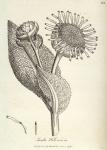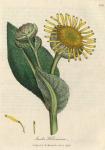108. Inula Helenium. Common Inula, or Elecampane.

 Synonyma. Enula Campana. Pharm. Lond.
Synonyma. Enula Campana. Pharm. Lond.
Helenium. Gerard Emac. p. 793. Raii. Hist. p. 273. Synop. p. 176.
Helenium vulgare. Bauh. Pin. p. 276.
Helenium sive Enula campana. J. Bauh. Hist. iii. p. 108. Park. Theat. p. 654.
After foliis ovato-lanceolatis, serratis, subtus tomentosis, calycinis ovato-lanceolatis, maximis. Hal. Stirp. Helv. n. 72.
Inula Helenium. Hudson Flor. Ang. p. 368. With. Bot. Arr. p. 922. Flor. Dan. 728.
Class Syngenesia. Ord. Polygamia Superflua. Lin. Gen. Plant. 956.
Ess. Gen. Ch. Recept. nudum. Pappus simplex. Antherae basi in setas duas desinentes.
Spec. Char. T. foliis amplexicaulibus ovatis rugosis subtus tomentosis, calycum squamis ovatis.
THE root is perennial, large, thick, branched, externally brown or grey, infernally whitish: the stalk is upright, strong, round, striated, branched, beset with soft hairs, and rises three or four feet in height: the leaves are large, ovate, serrated, crouded with reticular veins, supplied with a strong fleshy midrib, on the upper pagina smooth, on the under downy: the leaves, which are placed on the upper part of the stem are sessile, and surround the branches, but those towards the bottom stand upon footstalks: the flowers are large, yellow, of the compound kind, and terminate the stem and branches: the calyx is composed of several rows of strong imbricated ovate segments: the corolla consists of numerous florets, which are of two kinds; those occupying the centre are of a regular tubular form, divided at the brim into five small segments, and are hermaphrodite, each containing five short filaments, which have their antherae united so as to form a hollow cylinder and a long germen, which supports a slender style, about the length of the tube, and furnished with a bifid stigma: the florets at the circumference are female, and at the lower part tubular, but at the upper ligulated or strap-shaped, and cut at the extremity into three narrow pointed teeth; the female part is similar to that in the hermaphrodite florets: the seeds are solitary, filiated, quadrangular, and furnished with a simple feather or pappus: the receptacle is naked and flat. It is a native of England, growing in moist meadows, and flowers in July and August.
It is probable, that Elecampane is the Helenium foliis verbasci of Dioscorides, [Lib. i. cap. 27.] and the Inula of Pliny, [Lib. xix. cap. 5.] who also mentions Helenium but as a very different plant. ["Helenium e lacrymis Helenae natum, & ideo in Helena insula laudatissimum. Est autem frutex humi se spargens dodorantibus ramulis, folio simili serpyllo." Lib. xxi. c. 9. The Innula is noticed by Horace: "Erucas virides, inulas ego primus amaras / Monstravi incoquere." Sat. 8. v. 51. ___ quum rapula plenus / Atque acidas mavult inulas. Sat. 2. v. 44.] Elecampane is seldom to be met with in its wild state, but it is commonly cultivated in gardens, from whence the shops are supplied with the root, which is the part directed for medicinal use. "This root, in its recent state, has a weaker and less grateful smell than when thoroughly dried and kept for a length of time, by which it is greatly improved, its odour then approaching to that of Florence orris. Its taste, on first being chewed, is glutinous and somewhat rancid, quickly succeeded by an aromatic bitterness and pungency. Spirituous liquors extract its virtues in greater perfection than watery; the former scarce elevate any thing in distillation; with the latter an essential oil arises, which concretes into white flakes: this possesses at first the flavour of the Elecampane, but generally loses it on keeping. An extract, made with water, possesses the bitterness and pungency of the root, but in a less degree than that made with spirit."
The high opinion entertained by the ancients of the virtues of Elecampane may be collected from the words of Schroder, who says, "Abstergit, discutit, aperit, pulmonica est. Stomacha, alexipharmaca, sudorifera, &c. Usus praecip. in tartaro pulmonum renumque attenuando, ac educendo, & hinc in tussi, asthmate, in cruditatibus ventriculi emendandis, ureteribus referandis, in peste, contagiosisque morbis arcendis, in scabie." [P. 602. See Alston's M. M, vol. i. p. 454.] Bergius also ascribes many virtues to this root, and from its sensible and chemical qualities it promises to be a medicine of some efficacy; but in the diseases in which it is principally recommended, as dyspepsia, pulmonary affections, and uterine obstructions, we have no satisfaftory evidence of its medicinal powers. [See Cullen's M. M. vol. it. p. 459.] One dram of this root in infusion, and from two drams to half an ounce in decoction, is said to be the dose usually given.

